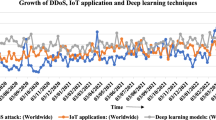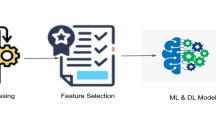Abstract
Internet of Things (IoT) is a promising profound technology with tremendous expansion and effect. However, IoT infrastructures are vulnerable to cyber-attacks due to the constraints in computation, storage, and communication capacity for the endpoint devices such as thermostat, home appliance, etc. It was reported that 99% of the cyber-attacks are developed by slightly mutating previously known attacks to generate a new attack tending to be handled as a benign traffic through the IoT network. In this research, we developed a new intelligent self-reliant system that can detect mutations of IoT cyber-attacks using deep convolutional neural network (CNN) leveraging the power of CUDA based Nvidia-Quad GPUs for parallel computation and processing. Specifically, the proposed system is composed of three subsystems: Feature Engineering subsystem, Feature Learning subsystem and Traffic classification subsystem. All subsystems are developed, verified, integrated, and validated in this research. To evaluate the developed system, we employed the NSL-KDD dataset which includes all the key attacks in the IoT computing. The simulation results showed a superior attacks’ classification accuracy over the state-of-art machine learning based intrusion detection systems employing similar dataset. The obtained results showed more than 99.3% and 98.2% of attacks’ classification accuracy for both binary-class classifier (normal vs anomaly) and multi-class classifier (five categories) respectively. All development steps and testing and verification results of the developed system are reported in the paper.
Access this chapter
Tax calculation will be finalised at checkout
Purchases are for personal use only
Similar content being viewed by others
References
Alrawais, A., Alhothaily, A., Hu, C., Cheng, X.: Fog Computing for the Internet of Things: Security and Privacy Issues. IEEE Internet Comput. 21(2), 34–42 (2017)
Chiti, F., et al.: Context-aware wireless mobile automatic computing and communications: research trends & emerging applications. IEEE Wirel. Commun. 23(2), 86–92 (2016)
Silva, B.N., Khan, M., Han, K.: Internet of things: a comprehensive review of enabling technologies, architecture, and challenges. IETE Tech. Rev. 35(2), 205–220 (2017). https://doi.org/10.1080/02564602.2016.1276416
Mahmoud, R. et. al. IoT security: current status. In: 10th International Conference for Internet Technology and Secured Transactions (ICITST), pp. 336 341 (2015)
Paar, C., Pelzl, J.: Understanding Cryptography. Springer, Berlin https://doi.org/10.1007/978-3-642-04101-3 (2010)
Caspi, G.: Introducing Deep Learning: Boosting Cybersecurity with An Artificial Brain. Informa Tech, Dark Reading, Analytics http://www.darkreading.com/analytics. (2016)
Taher, K.A., Jisan, B.M., and Rahman, M.M.: Network intrusion detection using supervised machine learning technique with feature selection. In: IEEE International Conference on Robotics, Electrical and Signal Processing Techniques, pp. 643–646 (2019)
Gao, X., Shan, C., Hu, C., Niu, Z., Liu, Z.: An adaptive ensemble machine learning model for intrusion detection. IEEE Access 7, 512–521 (2019)
Sapre, S., Ahmadi, P., Islam, K.: A Robust Comparison of the KDDCup99 and NSL-KDD IoT Network Intrusion Detection Datasets Through Various Machine Learning Algorithms. ar**v:1912.13204v1 [cs.LG]. (2019)
Chowdhury, M. et. al.: A few-shot deep learning approach for improved intrusion detection. In: IEEE 8th Annual Ubiquitous Computing, Electronics and Mobile Communication Conference (UEMCON), New York, pp. 456–462, https://doi.org/10.1109/uemcon.2017.8249084. (2017)
Niyaz, Q., Sun, W., Javaid, A.Y., Alam, M.: Deep learning approach for network intrusion detection system. In: ACM 9th EAI International Conference on Bio-inspired Information and Communications Technologies, New York (2016)
Yusof, A.R. et.al.: Adaptive feature selection for denial of services (DoS) attack. In: IEEE Conference on Application, Information and Network Security (AINS), Miri 2017, pp. 81–84 https://doi.org/10.1109/ains.2017.8270429. (2017)
Canadian Institute for Cybersecurity (CIS). NSL-KDD Dataset. https://www.unb.ca/cic/datasets/nsl.html. Retrieved on. (2019)
A. Ozgur and H. Erdem. A review of KDD99 dataset usage in intrusion detection and machine learning between 2010 and 2015. PeerJ Preprints 4:e1954v1. (2016)
C. Kolias, G. Kambourakis, A. Stavrou and J. Voas. DDoS in the IoT: Mirai and Other Botnets,” Journal of Computers, vol. 50 (7), pp. 80–84, https://doi.org/10.1109/mc.2017.201. (2017)
C. Ambedkar, V. Kishore Babu. Detection of Probe Attacks Using Machine Learning Techniques. International Journal of Research Studies in Computer Science and Engineering (IJRSCSE), Vol2, No. 3, Pp 25–29. (2015)
P. Pongle and G. Chavan. A survey: Attacks on RPL and 6LoWPAN in IoT,” 2015 International Conference on Pervasive Computing (ICPC), Pune, 2015, pp. 1–6. https://doi.org/10.1109/pervasive.2015.7087034. (2015)
Bengio, Y., Courville, A., Vincent, P.: Representation learning: a review and new perspectives. IEEE Trans. Pattern Anal. Mach. Intell. 35(8), 1798–1828. ar**v:1206.5538. https://doi.org/10.1109/tpami.2013.50. PMID 23787338. (2013)
Sarkar, D.J.: Understanding Feature Engineering. Towards Data Science. Medium. https://towardsdatascience.com/tagged/tds-feature-engineering. (2018)
Brownlee, J.: A Gentle Introduction to Padding and Stride for Convolutional Neural Networks. Deep Learning for Computer Vision, Machine Learning Mastery. https://machinelearningmastery.com/padding-and-stride-for-convolutional-neural-networks (2019)
Kalay, A.: Preprocessing for Neural Networks - Normalization Techniques. Machine Learning, Github.IO. https://alfurka.github.io/2018-11-10-preprocessing-for-nn. (2018)
Li, F.: CS231n: Convolutional Neural Networks for Visual Recognition. Computer Science, Stanford University, http://cs231n.stanford.edu. (2019)
Brownlee, J.: A Gentle Introduction to the Rectified Linear Unit (ReLU). Deep Learning for Computer Vision, Machine Learning Master. https://machinelearningmastery.com. (2019)
Kim, P.: MATLAB Deep Learning with Machine Learning. Apress, Neural Networks and Artificial Intelligence (2017)
Author information
Authors and Affiliations
Corresponding author
Editor information
Editors and Affiliations
Rights and permissions
Copyright information
© 2021 The Author(s), under exclusive license to Springer Nature Switzerland AG
About this paper
Cite this paper
Al-Haija, Q.A., McCurry, C.D., Zein-Sabatto, S. (2021). Intelligent Self-reliant Cyber-Attacks Detection and Classification System for IoT Communication Using Deep Convolutional Neural Network. In: Ghita, B., Shiaeles, S. (eds) Selected Papers from the 12th International Networking Conference. INC 2020. Lecture Notes in Networks and Systems, vol 180. Springer, Cham. https://doi.org/10.1007/978-3-030-64758-2_8
Download citation
DOI: https://doi.org/10.1007/978-3-030-64758-2_8
Published:
Publisher Name: Springer, Cham
Print ISBN: 978-3-030-64757-5
Online ISBN: 978-3-030-64758-2
eBook Packages: EngineeringEngineering (R0)




